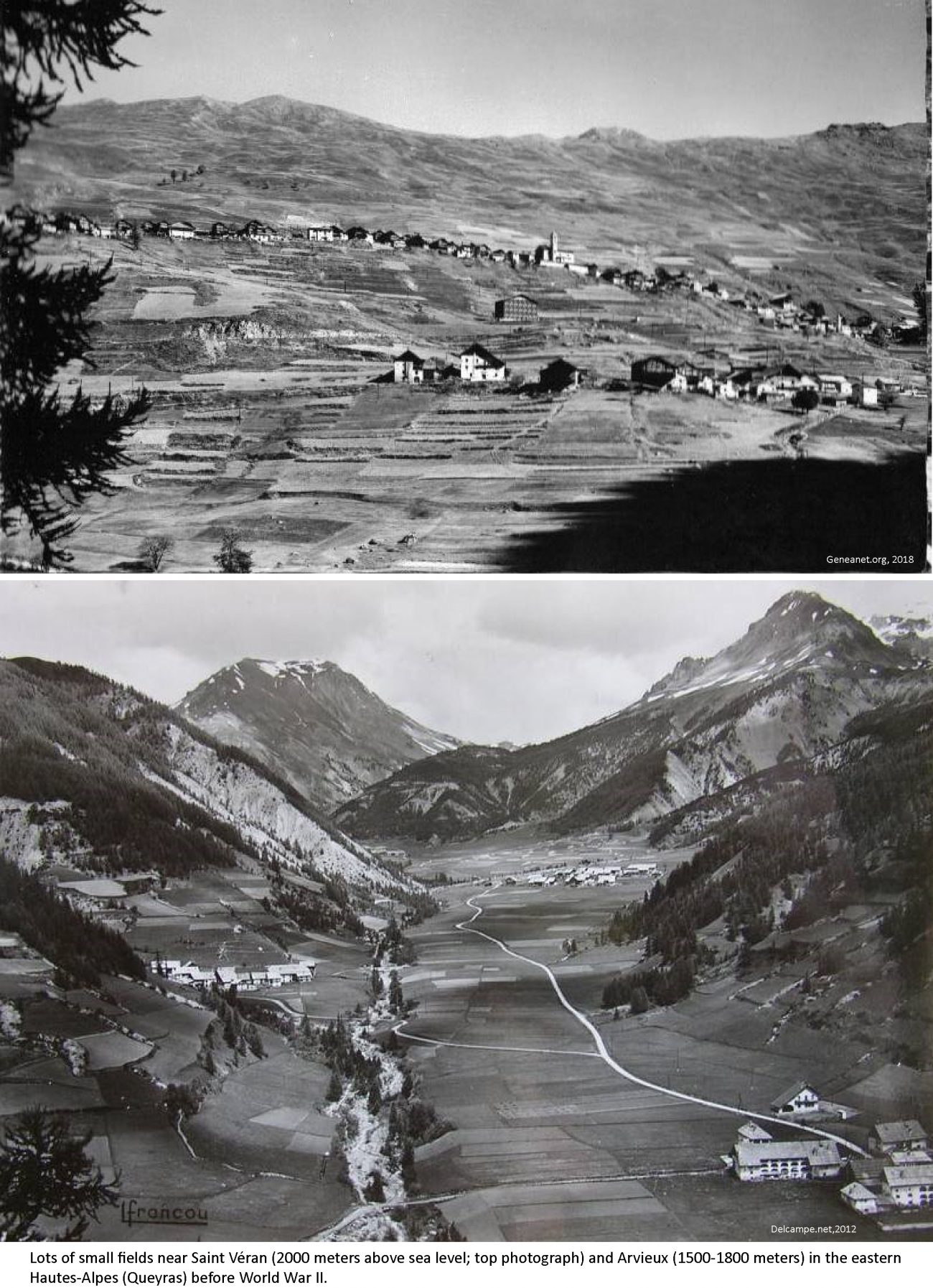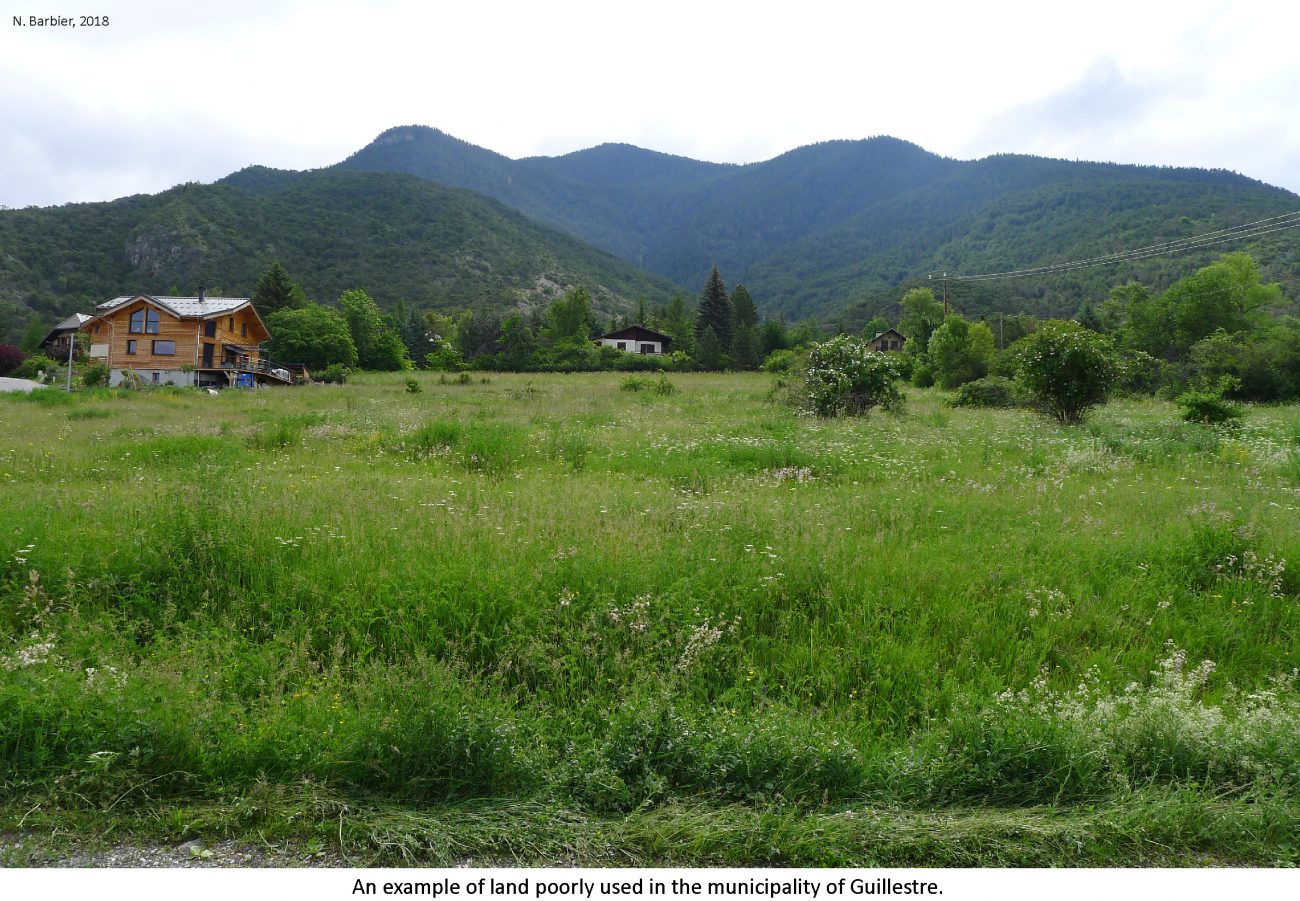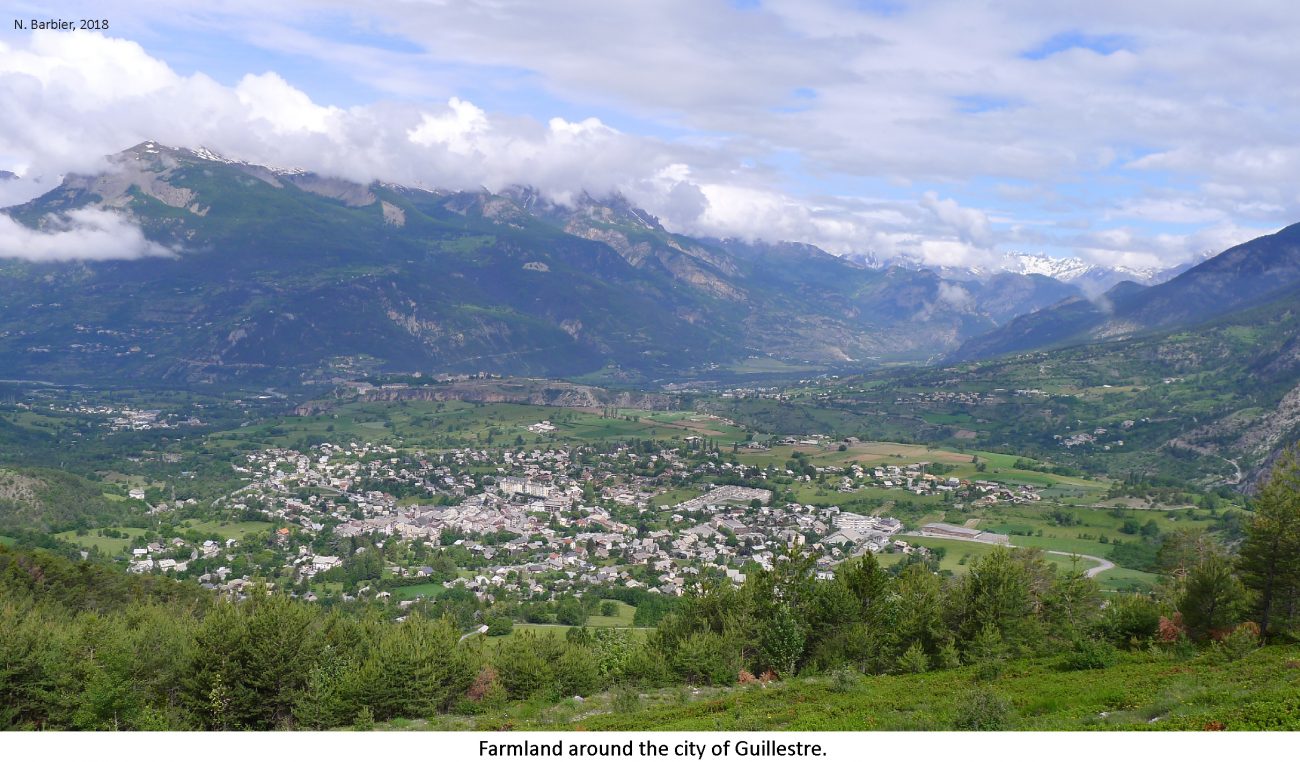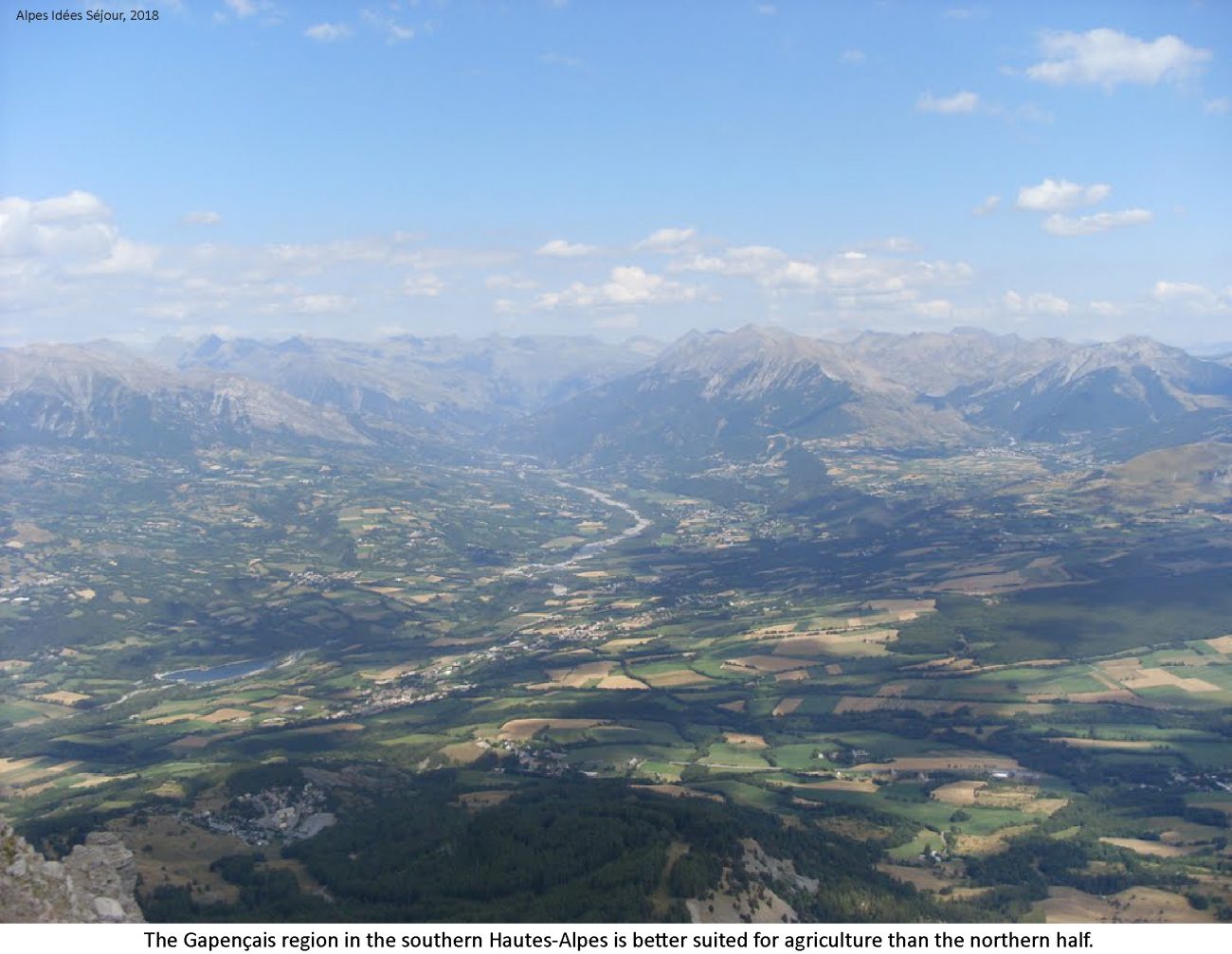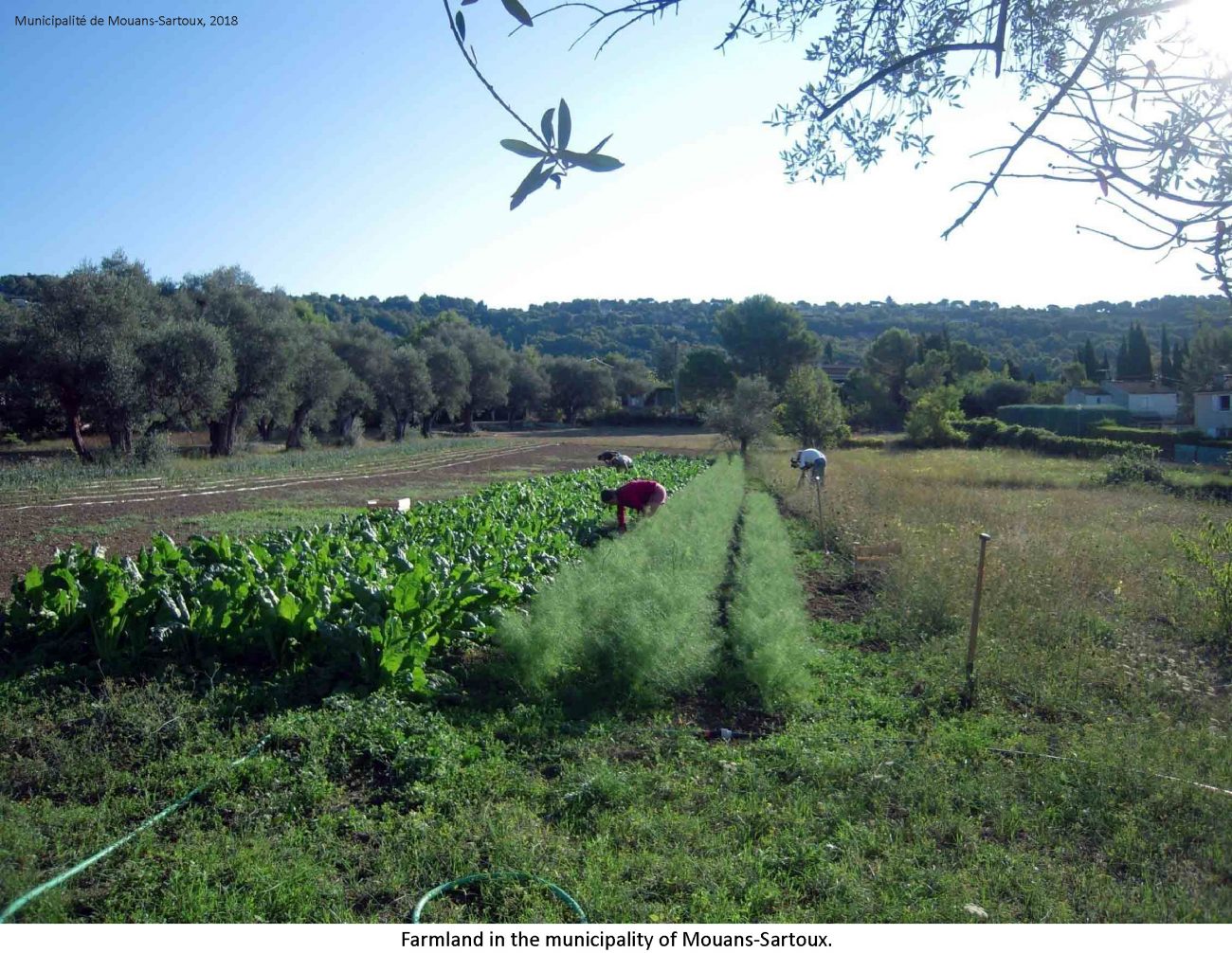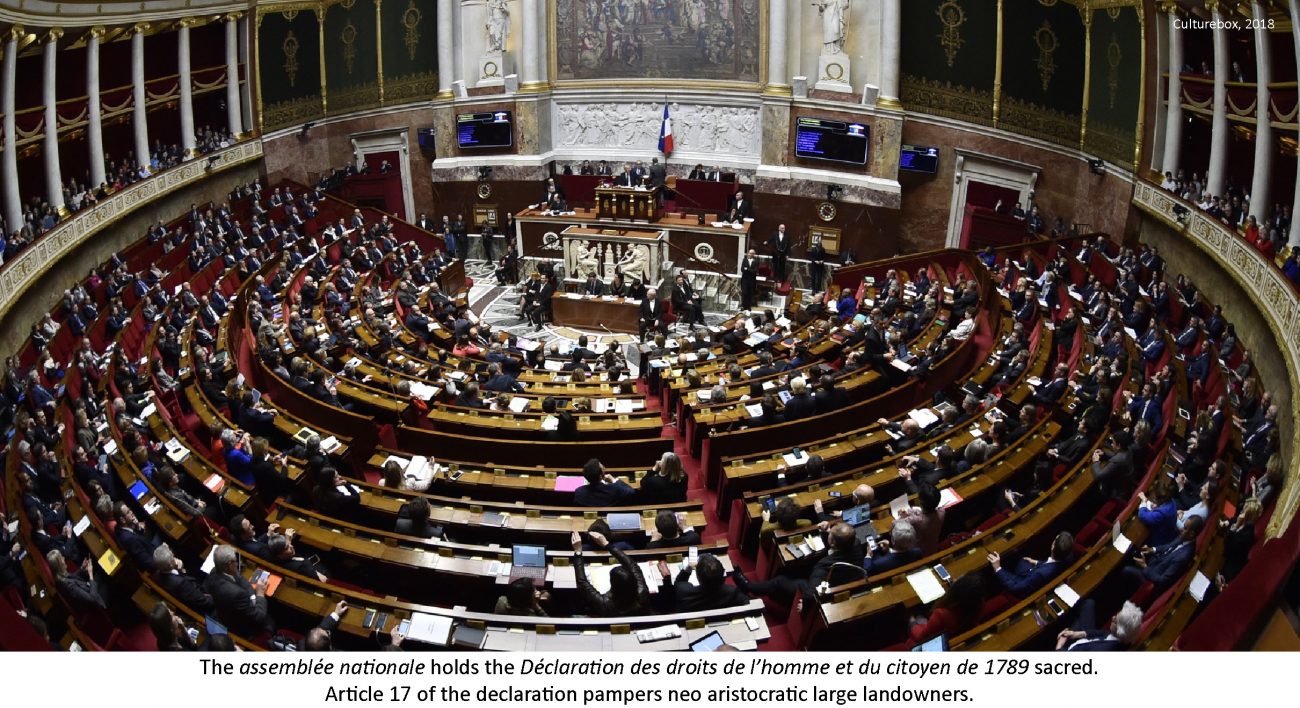Cars, sheep and large landowners: winning trio in the Hautes-Alpes (before hangover)
3. The lowness of large landowners on top of the Hautes-Alpes (courtesy of French legislators)
In the Hautes-Alpes in southern France as in other parts of the world, one can always focus on environmental and social accomplishments: the adequate protection of certain wildlife species; the welcoming of foreign migrants within organized groups and families; the efforts made by small farmers and consumers to sustain organic farming; the collection and treatment of compost at the municipal level; etc. But the scope of these accomplishments remains limited. They are never part of a lifestyle that could be considered truly balanced from economic and environmental standpoints. We don’t need to impose this lifestyle on others, but we need to be able to lead it without obstacles put in our way by hateful opponents. Prevailing trends, namely the immense social inequity rooted in our economic and legal systems and environmental mismanagement, stand in our way. In order to liberate people who want it from these scourges, we have to identify and explain them as clearly as possible. It helps us minimize cooperation with the insane established order and implement solutions consistent with both our needs as human beings and the needs of our environment. These are the two goals of this series of articles on the Hautes-Alpes.
1. Driving safely towards global warming
Subscribe to my newsletter
Buy PDF of part 3 (€2.00)
Buy eBook (.epub and .mobi) of part 3:
Hautes-Alpes - Part 3 (7/2018)
THE EXCESSES OF SHEEP PRODUCTION EXAMINED IN PART 2 ARE SYMPTOMATIC OF THE NEED TO REORGANIZE THE HAUTES-ALPES’ AGRICULTURAL ECONOMY. Giving up 80 percent of alpine pastures would eliminate jobs. They could be created elsewhere. In fact, the Hautes-Alpes could benefit from this evolution at the agricultural, environmental and social levels. The people who lost their jobs should be given various vocational retraining opportunities, including in small organic farming. In order to reorganize the agricultural economy in a sensible and fair manner, there should also be a much better sharing of farmland.
In France in general, the discriminatory and unfair distribution of farmland is mostly due to:
- Land laws.
- The greed of lots of landowners.
- A deep economic and social inequity.
Disparities in living standards are as enormous near snow-capped summits as in urban plains. In 2014 (latest available year) in the Hautes-Alpes, 18 percent of people under the age of 50 lived below the poverty level. That year, 28.5 percent of the Hauts-Alpins households[1] had an annual taxable income below 12,000 euros. On average, their annual taxable income was 6,400 euros. Meanwhile, 7.6 percent of households (taxable income of 50,000 euros and more) had an average taxable income of 77,000 euros. Moreover, 45 percent of housing units in the département of the Hautes-Alpes are either secondary homes or unoccupied most of the year (Insee, 2016 [a] et [b]; Ministère de l’action et des comptes publics, 2015).
It would not be relevant to compare the current economic situation with that of the past. But because I look into mountainous agriculture, it is important to understand the basics of the former agricultural economy. In the early 20th century, sheep production provided local people with milk, cheese, wool and hides. Cattle production gave them milk, cheese, but also meat. Sheep and cattle producers sold a part of their herds during regional fairs. This economy had another fundamental component which almost died out. Up until World War II, each Haut-Alpin village and hamlet was surrounded by small fields. They crept up south-facing slopes as high as 2,100 meters above sea level (photos 9). Local people drew a substantial part of their diet from their crops. Mountain farmers favored potatoes and rye. They also grew barley, cabbages, lentils and wheat. Thanks to the swift waters of mountain streams, water mills played a critical role in the regional economy. Their grinders turned the grain into flour which was used to make large quantities of bread as well as coarse flour for cattle (Arnaud, 1983, p.43-48, 55-56, 60-61; Tendil, 2010).
Photos 9
During the 20th century and especially after 1945, the ancestral patchwork of small fields was broken apart into increasingly scattered fields. Today, there are very few of them left. In many valleys, they have nearly disappeared. Five reasons explain this loss:
- Maximized farm profitability has been promoted by the agribusiness and backed by the French state. It has left little room for small mountain farms.
- Lots of mountain farmers became weary of their hard life which was much more demanding than other increasingly widespread and more comfortable lifestyles.
- The ever increasing average size of farms.
- The French state has been allocating the largest farm subsidies to the biggest and often most polluting farms, which has not worked in favor of small mountain farmers.
- The profound lack of support for a transition toward an economically viable and ecologically sensible mountain agriculture (Tendil, 2010).
Since 1945, most French legislators (at the parliament), most members of our national governments and most local elected officials have done everything they could to shrink small mountain farming. They have been successful.
So what could be done now? Around the Hautes-Alpes’ towns and villages, the growth potential of organic farming and related food businesses is very high. In the Champsaur, Embrunais, Gapençais, Guillestrois (photo 10), Queyras regions or elsewhere, large tracts of land are misused. Sporadically used pastures, abandoned orchards or wastelands dot their landscapes. Other parcels of lands attached to houses and mansions are unoccupied most of the time. Besides, land speculation[2] is a common practice among landowners from the French Alps.
Photo 10
If « available » lands were used wisely, organic farming in mountainous regions and the related food businesses could generate thousands of new jobs in the Hautes-Alpes alone. Small organic farming is labor intensive. Different sustainable activities could partake in this renewal of organic mountain agriculture. Old water mills would be renovated, new ones would be built and all would apply current food safety standards. New small grocery stores and restaurants would inevitably spring up. Storage facilities for organic foodstuffs, seeds, grain and plants would be required. Collective kitchens in schools and hospitals could even play a part in this process if they are willing to tap into local resources. Electric trucks fueled by efficient mountainous solar farms could be part of the deal to ensure that the necessary deliveries are made. In order for people to avoid jobs involving a unique task often perceived as mind-numbing, short training programs would give them an opportunity to do varied meaningful tasks (e.g., deliveries and some farming tasks; working in water mills and kitchens).
The number of jobs that could be created through this renewal would dwarf those lost with the abandonment of 80 percent of alpine pastures. Small cattle, sheep, poultry and pig operations would be part of this renewal to the benefit of both businesses and buyers. Agricultural jobs would not be based on widespread environmental degradation anymore. Today, most of them are. Instead, farming would be thoughtfully incorporated into the mountains.
To be complete, this agricultural renewal should include pay equity, that is to say the same wage for all people for equal work hours and quality. The pay could be a little higher for physically harder tasks. This wage system is the best way to truly respect every worker. Pay equity in agriculture and related food businesses would give momentum to a genuine regional solidarity. It would be a good start to replace the current forms of social welfare and charity, which in most cases sustain and reinforce a deeply inequitable economic system.
This renewal in organic agriculture and food production would revitalize a lot of municipalities. But it cannot be applied today. Three major obstacles prevent its implementation:
- Landowners willing to sell small fractions of their land they do not need to live well are ordinarily very hard to find. Though I do not intend to become a small organic farmer, my local experience is worth noting. It provides insight into the landowners’ prevalent behavior towards landless people. In 2017 in Guillestre (photo 11), I phoned a dozen landowners. I asked them if they would be willing to sell (preferably) or lease a little less than one tenth of a hectare of farmland. My girlfriend and I wanted to use this small parcel as an organic fruit and vegetable garden. No landowner was willing to even discuss this possibility.
- The French parliament, the executive branch of our national government and most local elected officials make the purchase of farmland difficult, insufficient or impossible for would-be small farmers who do not have lots of money or who have no chance of receiving a substantial inheritance.
- In the French Alps, farmland tends to become more and more expensive.
Photo 11
A very small minority of people living in the Hautes-Alpes and a small number of out-of-département people own most of the Hautes-Alpes’ farmland. Between 1999 and 2016, the average price of farmland in the Hautes-Alpes doubled from 3,900 to 7,800 current euros. It is worse in the eastern portion of this département where it soared from 4,400 to 11,600 current euros. The French parliament and government have let the highest regional farmland prices skyrocket to over 37,000 euros per hectare in some areas (Agreste, 2016).
From the most rugged agricultural lands of the Alps to northern France’s « great plains », there has been a long-lasting trend towards ever bigger farms. It is common for farms to be a mix of private and leased lands. In the Région Sud, north of which lie the Hautes-Alpes, the number of farms was cut by half from 40,000 to 21,000 between 1990 and 2013. In 2013, 45 percent of the Hautes-Alpes’ farms covered more than 50 hectares, which is a lot of land in a mountainous area. Only 22 percent of the département‘s farms (410 units) covered less than 10 hectares (Chambres d’agriculture PACA, 2018 [b]).
Let’s take a closer look at farmlands in the municipality of Guillestre, home of 2,300 people. I have been living here for about eighteen months. The mayor (M. Bernard Leterrier) is a member of the French green party (Europe-Ecologie-Les-Verts). Aside from alpine pastures, there are over 480 hectares of farmland within Guillestre’s municipal boundaries, most of which is blessed with a high potential. The average size of farms, excluding alpine pastures, is 63 hectares, with a range of size from 1 to 26. In 2016, the municipality released its urban project (plan local d’urbanisme). It deals with all land uses including farmland. The urban project identifies « critical issues » such as the « consolidation of current farms ». It prioritizes « development projects put forward by current farmers » and the assembly of land into larger parcels. The municipality wants to preserve the extremely rare small farms such as the potazer du Villard which produces organic seedlings, seeds and vegetables. But its urban project does not mention the development of new ones. In Guillestre, it is not going to be easy for would-be small organic farmers to buy land, whether or not they have money. In this municipality, 5 percent of private landowners (property accounts) own 52 percent of private lands (473 hectares out of a total of 914 hectares). In terms of the housing market, average prices are highly discriminating. A 100 square-meter house costs about 200,000 euros and you need 180,000 euros or so to buy an apartment of the same size. In « green » municipalities, priority is given to big farmers and landowners too (Guillestre, 2016, p.16-17, 27, 30; Guillestre, 2015, p.15, 23-29; MeilleursAgents.com, 2018).
The organic community garden arranged by the municipality of Guillestre (in cooperation with the Région Sud) covers less than half an hectare. Only twenty households or so, usually of modest means, take care of individual parcels, each of which is less than 50 m². Basic gardening tools are provided. At first on a waiting list, my girlfriend and I got a parcel because a household unexpectedly left. If not, we might never have had the opportunity to get one.
We had another idea. In October 2017, we wrote a letter to the mayor of Guillestre. We asked him if we could purchase a parcel of 500 to 800 m² (less than one tenth of an hectare). Our goal was to take care of a larger organic fruit and vegetable garden. Bernard Leterrier never responded. In Guillestre, several hectares of municipal lands could be converted into individual organic gardens. More importantly, there are 46 hectares of vacant lands without owner. From a legal standpoint, it is rather easy for a municipality to recover this sort of lands[3]. But the mayor is not interested. On top of this, Guillestre’s urban project admits that « a lot of private parcels are unused and lose their potential » (Guillestre, 2016, p.27; Guillestre, 2015, p.15, 23-30).
Just like Guillestre, the neighboring town of Eygliers is anything but a haven for small organic farming. In this municipality, sheep and cattle production dominates over the 660 hectares of alpine, subalpine and montane pastures. More than three-quarters of the 200 other hectares of farmland are concentrated around the village center and are reserved for… sheep and cattle. Most of this area is used as short-lived pastures. Because of this senseless spatial distribution of land uses, the potential development of profitable small organic farms is extremely limited. In Eygliers, the 50 remaining hectares are used for cereals, and a good part of their crops feed… cattle and sheep. On about two hectares of land, small organic farmer Fanny Lhermitte is an exception. She farms another hectare nearby. Never mind that the gradual disappearance of terraces for cereals, ignored by sheep producers, makes the soil more prone to erosion (Eygliers, 2017, p.20).
Browsing the internet, you can find parcels of farmland in the southern French Alps (www.proprietes-rurales.com ; https://www.avendrealouer.fr ; https://www.leboncoin.fr/, etc.). But decent prices for parcels of less than 10 hectares are rare gems. In addition, they are not necessarily suitable for small organic farming. For non-profit fruit and vegetable gardeners, small parcels for sale are rather exceptional and they are often located a long way from the main towns.
So what’s left for would-be small organic farmers who want to own an economically viable piece of land when they have neither much money nor the support of local farmers or elected officials? Not much. There is one regional constant. Whether they live in the upper valleys or in the more hospitable southern Hautes-Alpes (photo 12), their initial burden is usually great.
Photo 12
Between 2011 and 2015, only 24 new farmers settled in the 38 municipalities of the Briançonnais, Ecrins, Guillestrois and Queyras regions put together. Seventeen of them settled to raise domesticated animals. Between 1979 and 2010 in this northern part of the Hautes-Alpes, the average utilized area per farm increased from 12 to 57 hectares. In this area, there are only three associations supporting small organic farming (AMAP biologique). These associations may be critical to the maintenance of small organic farms more economically exposed to production variations than large conventional farms. Indeed, associations’ members usually commit themselves to supporting the farmers regardless of those variations (PETR Briançonnais-Ecrins-Guillestrois-Queyras, 2016, p.15-16).
From the Hautes-Alpes to the European Union (EU), small organic farms are anything but an agricultural priority. At the EU level, the Common Agricultural Policy (CAP) enacted every seven years speaks volumes. Under the 2014-2020 CAP, EU funds allocated to French organic agriculture represent less than 2 percent (180 million euros) of all EU funds allocated to French agriculture (9.1 billion euros) (Ministère de l’agriculture, de l’agroalimentaire et de la forêt, 2016, p.12).
Under the French national ministries of agriculture and finance, rural land use planning agencies (Safers) follow this trend. A seller of farmland can appeal to a regional Safer so that the latter buy the land for sale. Then the Safer selects one of the aspirant buyers. The sale is completed once a ministerial representative agrees with the sale. This common process for farmland sale is tightly controlled by the French government. Just like the French parliament, the EU and most local elected officials, the Safers and the government do not pursue a socially and economically fair distribution of farmland whatsoever (Safer 2018, [a], [b], [c] et [d]).
On the margins of this prevailing nationwide tendency, very few local elected officials have made notable efforts. In order to find an example, we even need to get out of the Hautes-Alpes and go south to Mouans-Sartoux (10,000 inhabitants), not far from the Mediterranean Sea (photo 13). In its 2012 urban project, this municipality increased the size of farmland almost threefold overnight. However, this decision follows a huge loss of farmland during the second half of the 20th century. Amongst the lands converted into farmland, the municipality purchased a former four-hectare farm and turned it into an organic fruit and vegetable farm. A lady employed by the city of Mouans-Sartoux has been running it since then. She supplies local school canteens with fresh fruit and vegetables. Notably, at all the city’s school canteens where 1,000 children are having lunch daily, meals are 100 percent organic. If the municipality’s efforts are commendable, they should not be praised. Nor should they conceal other key facts:
- The city is located in an area (Les Alpes niçoises) where farmland prices ordinarily exceed 9,000 euros per hectare.
- A big chunk of the municipal area was until recently nibbled away by poorly designed residential housing projects.
- In 2015, Mouans-Sartoux’s municipal services per person reached 1,700 euros, which is significantly higher than the French average of 1,200 euros. So no wonder that Mouans-Sartoux is better able to pay between 2.20 and 6.40 euros per meal in organic canteens.
- The 2012’s sudden expansion of farmland from 40 to 112 hectares is modest when compared with the municipality’s area of 1,300 hectares.
- Only 23 families have got an organic fruit and vegetable garden. Less than 1 acre of municipal land is used for that purpose.
- Mouans-Sartoux remains a very rare case in France (Agreste, 2016; Association des jardins familiaux des Canebiers, 2013; Département du Var, 2012, p.69, 77; JDN, 2018; Mouans-Sartoux, 2012, p.64, 95; Rouchard, 2018).
Photo 13
In the Hautes-Alpes and France as a whole, cutting farmland prices by 60 to 90 percent depending on location[4] does not require a revolution. Nor does the reallocation of parts of farmlands owned by rich people for the benefit of those who really need it. It would mean the pursuit of elementary equity and genuine common good[5] in terms of land distribution. The behavior of people rich in land and French political authorities is usually the exact opposite. They never stop focusing on legal ways to maintain privileges in the long run for a very small minority of large landowners.
Only the legislators of the assemblée nationale, which is part of the French parliament[6], have authority to repeal existing farmland laws. Assuming that the French executive branch of government tries to repeal those laws, which is most unlikely, article 49-3 of the French constitution would probably prevent them from doing so. Indeed, most members of the assemblée nationale would have to agree with the government so as to repeal those laws (Vie publique, 2016).
Regardless of the political affiliation of the majority party at the assemblée nationale, our legislators will not make the decision to drastically reduce farmland prices. They will not reallocate parts of the farmlands owned by rich folks who don’t need these parts to live well either. Current French legislators (photo 14) have neither the willingness nor the courage to change French land laws. In order to do so effectively, they would have to do away with article 17 of the Déclaration des droits de l’homme et du citoyen de 1789 (Declaration of the rights of man and the citizen). This déclaration is part of French constitutional law. It has been held sacred for 229 years. Article 17 says that « property being a sacred and inviolable right, no one can be deprived of it, unless a legally established public necessity demands it, under the condition of a just and prior indemnity ». Even if legislators decided to take away farmlands from rich landowners for « legally established public necessity », these landowners would get « a just and prior indemnity ». Article 17 is one of the neo aristocratic core elements of French land laws which allow individuals to own huge properties (Conseil constitutionnel, 2018).
To give an idea of the extent of the land market for rich people, one just have to look at some websites where people can start the process of buying land. On July 18, 2018 on agriaffaires.com for instance, there were 24 private properties for sale ranging from 80 to 200 hectares. On immonot.com, there were 23 properties for sale from 80 to 1,300 hectares. On proprietes-rurales.com, there were 110 properties for sale from 80 to 590 hectares (Agriaffaires.com , 2018; Immonot.com, 2018; Proprietes-rurales.com, 2018).
Photo 14
Most current legislators and local elected officials shield land laws from deep changes by any legal means available to them. Let’s emphasize that these political authorities, be they from a conservative or leftist party, will not take the opportunity to force landowners who don’t need parts of their lands to live well to sell these parts at a very low price. Yet, if these lands were made available and prices were low enough, lots of small organic farmers could purchase them and live well, while countless people could get their own fruit and vegetable garden.
When it comes to land issues, nothing should be expected from the majority of French people. Many members of this majority are engaged in collaboration with our current political authorities. Many others are economically and socially too afraid to do anything significant when it comes to land issues. A lot of others are outright apathetic. As long as this situation continues, it will be hard to take actions that could make a local difference from a standpoint of environmental priority, economic fairness and social justice all at the same time. As long as this situation continues, the positive results of these actions will be partial and a long way from what we could do if we had the right political and legal context. This is the struggle we are faced with in the Hautes-Alpes and virtually anywhere in France. The same is true for many, if not most, parts of the world.
Among the ideas that I put forward on my blog ventdouxprod.com, I have tried to engage people in a local association whose goal is to recover lands. This idea could be replicated practically anywhere in France. The project’s title is Terres ensemble Hautes-Alpes (Together on Hautes-Alpes’ lands). It is about buying at market prices as much farmland and forest land from willing sellers as we possibly could. Members of the association would focus on three land uses that would be beneficial for them and the environment:
- Small organic farming.
- The protection and restoration of wildlife.
- The growing of organic industrial hemp.
Right now, potentially interested people are reluctant to get involved for one or more reasons, including the following:
- The uncertain duration of their stay in the area.
- The financial investment required.
- The unusual use of an association as a vehicle to buy land.
- Other personal issues.
I encourage these people to go beyond some of their hesitations:
- In case a member moves elsewhere, he or she would have contributed to an ecologically, economically and socially beneficial project this person could inspire from elsewhere.
- At 50 euros per year, the membership is by no means insignificant, but it is not very high either.
- The unusual use of an association to buy land can be overcome. Most importantly, once we become a strong cohesive group of landowners who rally around shared core values, it is certain that the French state will not be able restrict our actions as easily as they do when they deal with landless people.
We have no choice: we must keep struggling against socially and environmentally brutal minorities of local and national elected officials, large landowners and wealthy people. Many of them are addicted to the legal possibility to own much more material things than they need to live well. Others among them are addicted to the obsessive control of others. Actually, many of them are addicted to both. Those people have been shaping a large part of the Hautes-Alpes as they see fit. Crowds of voters follow in the footsteps of elected officials that they have elected.
Elected officials, large landowners and wealthy people have secured the legal protection of their own interests. Together they have civilized the mountains by denying and betraying their very nature. The truth is that these mountains are bountiful lands for the benefit of all people in the long run, provided that we respect their sobering laws.
Sources
Agreste, 2016. Prix moyens des terres et prés, nouvelles séries, évolution de 1999 à 2016 – terres et prés libres. 25/5/2018.
Agriaffaires.com , 2018. Vente ferme et terre agricole. 18/8/2018
Arnaud C., 1983. Une mémoire de Saint-Véran : vie traditionnelle et patois queyrassins. Le monde alpin et rhodanien – revue régionale d’ethnologie, 11-3, pp.5-103. 21/5/2018.
Association des jardins familiaux des Canebiers, 2013. Association Des Jardins Familiaux Des Canebiers. 18/6/2018.
Chambres d’agriculture PACA, 2018 [b]. Chiffres clés. 25/5/2018.
Conseil constitutionnel, 2018. Déclaration des Droits de l’Homme et du Citoyen de 1789. 4/6/2018.
Département du Var, 2012. IV- Le champ des possibles. 8/6/2018.
Eygliers, 2017. Révision générale du PLU d’Eygliers. 26/5/2018.
Guillestre, 2016. Révision générale du POS – Elaboration du PLU. 25/5/2018.
Guillestre, 2015. Diagnostic agricole et foncier sur la commune de Guillestre. (Document fourni par la maire de Guillestre).
Immonot.com, 2018. 23 annonces immobilières de notaires. 18/8/2018.
Insee, 2016 [a]. Dossier complet – Département des Hautes-Alpes (05) : FAM T2 – Ménages selon la catégorie socioprofessionnelle de la personne de référence en 2014. 19/5/2018.
Insee, 2016 [b]. Dossier complet – Département des Hautes-Alpes (05) : LOG T1 – Évolution du nombre de logements par catégorie. 21/05/2018.
JDN, 2018. Budget municipal de Mouans-Sartoux (06370) – Budget général. 11/6/2018.
MeilleursAgents.com, 2018. Prix immobilier à Guillestre (05600). 8/6/2018.
Ministère de l’action et des comptes publics, 2015. Département : Hautes-Alpes. Ircom 2015 (revenus 2014). 30/5/2018.
Ministère de l’agriculture, de l’agroalimentaire et de la forêt, 2016. La réforme de la PAC en un coup d’oeil. 4/6/2018.
Mouans-Sartoux, 2012. Plan local d’urbanisme – Rapport de présentation. 8/6/2018.
PETR Briançonnais-Ecrins-Guillestrois-Queyras, 2016. Projet de territoire du Briançonnais, des Ecrins, du Guillestrois et du Queyras 2016-2020. 26/5/2018.
Proprietes-rurales.com, 2018. Propriété à vendre. 18/8/2018.
Rouchard S., 2018. La cantine bio de Mouans-Sartoux nourrit bien élèves et paysans. Reporterre. 8/6/2018.
Safer, 2018 [a]. Les Safer : l’essentiel. 4/6/2018.
Safer, 2018 [b]. Vendez un bien. 4/6/2018.
Safer, 2018 [c]. Le droit de préemption, qu’est-ce que c’est ? 4/6/2018.
Safer, 2018 [d]. Comment est choisi l’acheteur ? 4/6/2018.
Tendil M., 2010. Agriculture de montagne – Queyras : les derniers des paysans ? Localtis. 21/5/2018.
Vie publique, 2016. Le recours à l’article 49.3 de la Constitution. 4/6/2018.
ventdouxprod 2018, all rights reserved
Footnotes
[1] This calculation is based on national income tax data. In this case, an household means all the persons on the same income tax return.
[2] Land speculation consists in buying land while looking for a subsequent profit through its sale.
[3] These vacant lands without owner have two main characteristics. First, there is no document proving that the parcel was part of the local land registry when it was created. Second, all potential owners would be 100 years old or more if they were alive (Guillestre 2015, p.29).
[4] Where farmland prices are the most extreme, for instance in some places in the eastern Hautes-Alpes where they have soared to more than 37,000 euros per hectare, it would make sense to cut farmland prices by 90 percent or so. Elsewhere, cutting prices by 60 percent should be enough for people without lots of money to become small landowners.
[5] In this instance, the common good means what is beneficial for society in the long run.
[6] The assemblée nationale is one of the two houses of the French parliament. The second house is the French senate.

